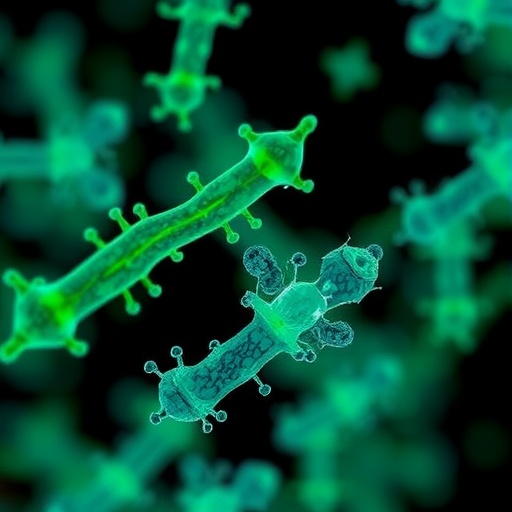In an era where machine learning is revolutionizing various fields, its application in understanding the biological mechanisms of life is particularly fascinating. A groundbreaking study published in BMC Genomics has demonstrated how machine learning algorithms can predict the optimal growth temperatures of bacteria by analyzing protein domain signatures. This innovative research not only provides insights into the thermoadaptation mechanisms employed by various bacterial species but may also pave the way for advancements in biotechnology and synthetic biology.
The researchers, led by Liu and his team, embarked on a journey to unravel the complexities of thermoadaptation. Every organism on our planet has a preferred temperature range in which it thrives, and bacteria are no exception. However, the challenge lies in the vast array of environmental conditions these microorganisms endure. The ability to discern the optimal growth temperature of bacteria can have significant implications for understanding their ecological roles, evolutionary history, and potential applications in biotechnology.
At the heart of this research is the analysis of protein domains, the functional units of proteins that dictate specific biological activities. By focusing on these structural components, researchers could uncover patterns that correlate with temperature adaptability. The study harnesses the power of machine learning, which excels in identifying intricate patterns within vast datasets, making it an ideal tool for such biological discoveries.
Machine learning algorithms require extensive training data to make accurate predictions, and this study is no exception. The researchers compiled a comprehensive database of bacterial species, encompassing a wide range of environments and growth temperatures. By integrating this biological data with advanced algorithms, they were able to train the model in such a way that it could predict the optimal growth temperatures of previously untested bacterial strains with surprising accuracy.
The findings from this study shed light on the relationship between protein structures and temperature tolerance in bacteria. It was observed that certain protein domains are found more frequently in species thriving at higher temperatures, while others dominate in those adapted to cooler environments. These insights could help scientists understand how evolutionary pressures have shaped the genomic architecture of bacteria over millions of years.
Moreover, understanding bacterial thermoadaptation has practical implications, particularly in industries such as biotechnology. For instance, if researchers can pinpoint the optimal growth conditions for specific bacterial strains, they can optimize fermentation processes used in the production of antibiotics, enzymes, or biofuels. Additionally, this knowledge may aid in bioremediation efforts, where certain bacteria are employed to clean up polluted environments, as it becomes possible to cultivate these microorganisms under their ideal conditions for maximum efficiency.
The study also raises intriguing questions regarding the potential use of machine learning beyond bacterial thermoadaptation. The methodologies developed could be applied to other biological systems, providing a framework for predicting various physiological characteristics across different organisms. This could result in significant breakthroughs in fields ranging from agriculture to medicine, expanding our understanding of life itself.
As this research continues to gain traction, it emphasizes the need for interdisciplinary collaboration between computer scientists and biologists. The fusion of these fields opens avenues for innovation that were previously unimaginable. As technology evolves, the prospect of utilizing machine learning to explore biological phenomena will likely become the norm rather than the exception, proposing new frontiers in the study of life forms.
Furthermore, as the implications of this research unfold, it also invites scrutiny on issues related to bioethics and the consequences of manipulating microbial life. The prospect of harnessing bacteria for human benefit poses questions about the ecological ramifications and the governance of such biotechnological advancements. Ethical considerations will need to be prioritized as scientists navigate this new landscape.
In conclusion, Liu and his colleagues’ study represents a significant advancement in our understanding of bacterial thermoadaptation through the lens of machine learning. By connecting protein domain signatures to optimal growth temperatures, this research not only contributes to the fundamental knowledge of microbial biology but also offers pathways for real-world applications. As the scientific community embraces the power of machine learning, the future holds exciting prospects that could reshape our relationship with the microbial world and the boundaries of biotechnological potential.
In summary, the use of advanced computational techniques to study biological phenomena illustrates the paradigm shift in modern science. Liu et al.’s work serves as a beacon of innovation and exemplifies how interdisciplinary approaches can lead to breakthroughs in understanding life. With the fusion of biology and artificial intelligence, we are but on the verge of a new chapter in scientific discovery, promising to unlock the mysteries of the microbial realm and how it can be harnessed for the benefit of humanity.
Subject of Research: Predicting bacterial optimal growth temperature using machine learning.
Article Title: Machine learning prediction of bacterial optimal growth temperature from protein domain signatures reveals thermoadaptation mechanisms.
Article References:
Liu, H., Zhu, G., Chen, L. et al. Machine learning prediction of bacterial optimal growth temperature from protein domain signatures reveals thermoadaptation mechanisms.
BMC Genomics 26, 957 (2025). https://doi.org/10.1186/s12864-025-12162-z
Image Credits: AI Generated
DOI: 10.1186/s12864-025-12162-z
Keywords: Machine learning, bacterial thermoadaptation, protein domains, biotechnology, microbial ecology.




